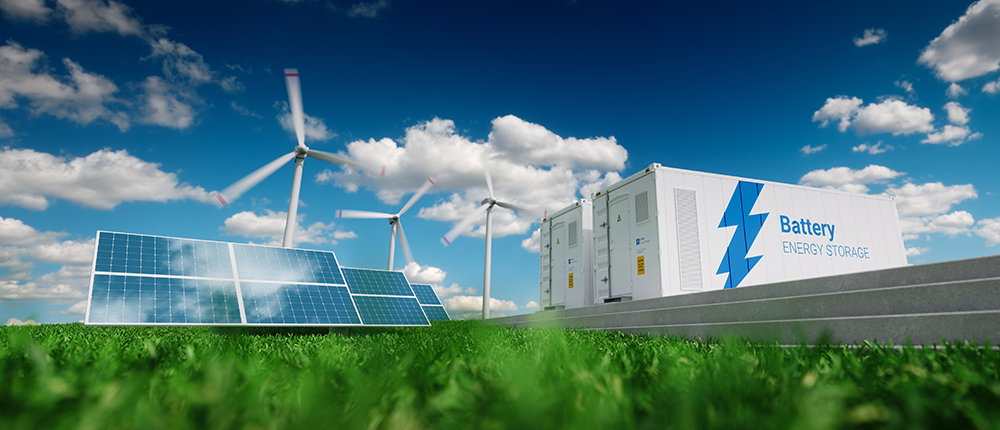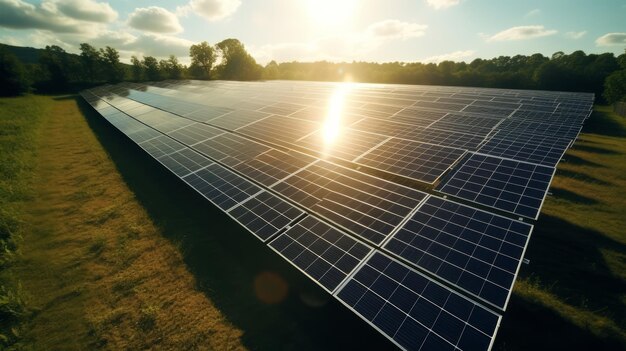
The Future of Battery Storage for Renewable Energy: Powering a Sustainable World
Imagine a world where the sun always shines and the wind always blows – at least when we need power. The truth is, solar panels only generate electricity when the sun is out, and wind turbines only spin when the wind is blowing. This creates a big challenge for our electricity grid: how do we keep the lights on when our renewable energy sources take a break?
The answer lies in battery storage. Just like the battery in your phone stores energy to power it even when it’s unplugged, large-scale batteries can store excess renewable energy to be used later. This is not just a clever idea; it’s the missing piece of the puzzle that will truly unlock the full potential of renewable energy and power a cleaner, more sustainable future for everyone.
Why is Battery Storage So Important for Renewables?
Renewable energy sources like solar and wind are fantastic, but they have a key characteristic: they are intermittent. This means their output isn’t constant.
- Solar power peaks during the day but produces nothing at night.
- Wind power varies with weather patterns, sometimes strong, sometimes calm.
This "on-again, off-again" nature makes it hard to rely solely on renewables for a stable electricity supply. That’s where battery storage steps in, acting like a giant energy bank.
Here’s why it’s so crucial:
- Bridging the Gap: Batteries store energy when renewables are abundant (e.g., sunny midday) and release it when demand is high or generation is low (e.g., evening peak, cloudy day).
- Grid Stability: They help balance the supply and demand of electricity, preventing blackouts and ensuring a steady flow of power. This is like a shock absorber for the grid.
- Maximizing Renewable Potential: Without storage, a lot of renewable energy might go to waste if it’s generated faster than it can be used. Batteries ensure every electron counts.
- Reducing Fossil Fuel Reliance: By storing renewables, we reduce the need to fire up power plants that burn coal or natural gas to fill in the gaps.
- Energy Independence: Countries and communities can become more self-sufficient in their energy needs, relying less on imported fuels.
Current Champion: Lithium-ion Batteries
Today, when you hear about large-scale battery storage, the first type that comes to mind is often lithium-ion (Li-ion). These are the same basic batteries that power your smartphone, laptop, and electric car, just on a much bigger scale.
Why are Lithium-ion Batteries so Popular?
- High Energy Density: They can store a lot of energy in a relatively small space. This is why EVs can travel far on a single charge.
- Good Efficiency: They are good at converting stored energy back into usable electricity with minimal loss.
- Rapid Development: Thanks to the booming electric vehicle market, lithium-ion technology has seen massive investment, leading to significant cost reductions and performance improvements.
However, Lithium-ion Batteries Also Have Limitations:
- Cost: While falling, they can still be expensive for very large, long-duration storage projects.
- Raw Materials: Lithium, cobalt, and nickel are finite resources, and their mining can have environmental and social impacts.
- Lifespan: Like your phone battery, they degrade over time and have a limited number of charge-discharge cycles.
- Safety Concerns: In rare cases, they can overheat (thermal runaway), posing a fire risk, though safety features are constantly improving.
- Recycling Challenges: While efforts are underway, large-scale, efficient recycling of Li-ion batteries is still developing.
The Next Generation: Beyond Lithium-ion
While lithium-ion batteries are the workhorses of today’s energy storage, scientists and engineers are hard at work developing exciting new battery technologies that promise to overcome current limitations and offer even better solutions for the future.
Here are some of the most promising contenders:
1. Solid-State Batteries
- How they work: Instead of a liquid or gel electrolyte (the part that allows ions to move between the positive and negative terminals), solid-state batteries use a solid material.
- Potential Benefits:
- Enhanced Safety: Eliminating flammable liquid electrolytes greatly reduces the risk of fires.
- Higher Energy Density: They could potentially store even more energy in a smaller package, leading to smaller, more powerful batteries.
- Longer Lifespan: Some designs promise more charge cycles before degradation.
2. Flow Batteries
- How they work: Unlike traditional batteries that store energy within solid electrodes, flow batteries store energy in liquid electrolytes contained in external tanks. The liquids are pumped through a central cell where chemical reactions occur to charge or discharge.
- Potential Benefits:
- Scalability: The amount of energy stored depends on the size of the tanks, making them easy to scale up for very long-duration, utility-scale storage.
- Long Lifespan: The active materials don’t degrade much over time, leading to very long operating lives (often 20+ years).
- Safety: They use non-flammable, water-based electrolytes, making them inherently safer.
- Decoupled Power and Energy: You can design them for different power outputs and energy capacities independently, which is great for various grid needs.
3. Sodium-ion Batteries
- How they work: Similar to lithium-ion, but they use abundant and cheap sodium instead of lithium.
- Potential Benefits:
- Lower Cost: Sodium is far more abundant and cheaper than lithium, making these batteries potentially much more affordable.
- Sustainability: Less reliance on scarce minerals.
- Better Performance in Cold Weather: Some designs show better performance in very cold temperatures compared to Li-ion.
- Safer Materials: Sodium-ion batteries are often less prone to thermal runaway than some lithium-ion chemistries.
4. Other Emerging Technologies
The research doesn’t stop there! Other exciting concepts include:
- Zinc-air batteries: Use readily available zinc and oxygen from the air.
- Iron-air batteries: Similar concept, using iron.
- Gravity-based storage: Uses excess energy to lift heavy weights, then releases energy by lowering them (like a giant yo-yo!).
- Compressed Air Energy Storage (CAES): Uses excess electricity to compress air into underground caverns, then releases it to drive turbines.
Each of these technologies has unique strengths, and the future will likely see a mix of different battery types used for different applications, depending on the required duration, power, cost, and location.
Key Trends Shaping the Future of Battery Storage
The journey to a fully renewable grid isn’t just about new battery types; it’s also about ongoing innovation in how we make, use, and manage these energy powerhouses.
- Continued Cost Reduction: As manufacturing scales up and technology improves, the price of batteries is expected to keep dropping, making them even more competitive with traditional power sources.
- Increased Energy Density & Lifespan: Batteries will become more compact, hold more energy, and last for more charge-discharge cycles, reducing the need for frequent replacements.
- Enhanced Safety: Research is heavily focused on developing inherently safer battery chemistries and sophisticated management systems to prevent any risks.
- Improved Sustainability & Recycling: A "circular economy" for batteries is a major goal. This includes using more sustainable materials, designing batteries for easier disassembly, and developing efficient large-scale recycling processes to recover valuable materials.
- Smart Grid Integration & AI: Batteries will become smarter, working seamlessly with the grid. Artificial intelligence (AI) will play a huge role in optimizing when to charge and discharge batteries based on real-time electricity prices, weather forecasts, and demand predictions.
- Modular and Scalable Designs: Batteries will be designed in modular units that can be easily combined to create storage systems of any size, from small home units to massive utility-scale installations.
Real-World Applications: Where We’ll See Batteries
Battery storage won’t just be behind the scenes; it will integrate into almost every aspect of our energy lives.
- Utility-Scale Storage: Massive battery farms connected directly to the main electricity grid will store vast amounts of renewable energy from large solar and wind farms, ensuring grid stability and providing power during peak demand.
- Residential & Commercial Storage: Homeowners with rooftop solar panels will increasingly install batteries to store excess daytime energy for use at night or during power outages. Businesses will use them to reduce their electricity bills by storing cheap off-peak power.
- Electric Vehicles (EVs) as Mobile Storage: Your electric car could become a mobile power bank! Vehicle-to-Grid (V2G) technology allows EVs to not only draw power from the grid but also send excess power back during times of high demand, acting as a distributed network of small battery storage units.
- Microgrids: Small, localized energy systems (for campuses, islands, or remote communities) can combine local renewable generation with battery storage to operate independently from the main grid, providing resilience and energy security.
- Off-Grid Solutions: For remote areas without grid access, batteries combined with solar or wind will provide reliable, clean power, replacing noisy and polluting diesel generators.
Challenges on the Road Ahead
While the future of battery storage is bright, there are still hurdles to overcome:
- Raw Material Supply: Ensuring a sustainable and ethical supply of critical minerals for all battery types is crucial.
- Manufacturing Capacity: Building enough factories to produce the vast number of batteries needed for the global energy transition will require significant investment.
- Recycling Infrastructure: Developing a robust and cost-effective system for recycling all types of batteries at their end-of-life is essential to close the loop and minimize environmental impact.
- Policy and Regulation: Governments need to create supportive policies, incentives, and regulations that encourage investment in battery storage and integrate it effectively into electricity markets.
- Public Perception and Safety: Ensuring public trust through stringent safety standards and clear communication about battery technology is vital.
Conclusion
The future of battery storage is not just about bigger or better batteries; it’s about fundamentally transforming how we generate, distribute, and consume energy. By solving the intermittency challenge of renewable energy, batteries are paving the way for a world powered by clean, abundant, and sustainable sources.
From giant grid-scale installations to your electric car and home, batteries will be the silent workhorses of our new energy economy. While challenges remain, the rapid pace of innovation, coupled with a global commitment to decarbonization, ensures that battery storage will play an increasingly pivotal role in building a resilient, affordable, and truly sustainable energy future for generations to come. The era of clean energy is here, and batteries are powering its charge.



Post Comment